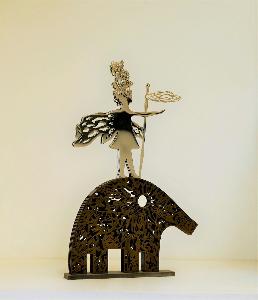Nadim Karam
Nadim Karam
Place: Beirut
Born: 1957
Biography:
Nadim Karam is a Lebanese artist and architect, born in Beirut in 1957. He is known for his large-scale urban art projects in different cities of the world, using his vocabulary of forms in urban settings to narrate stories and evoke collective memory with a whimsical, often absurdist approach.
Early Life and Education
Nadim Karam grew up in Beirut and received a Bachelor of Architecture from the American University of Beirut in 1982. He then left for Japan on a Monbusho scholarship to study at the University of Tokyo, where he developed an interest in Japanese philosophy of space under Hiroshi Hara, Fumihiko Maki, and Tadao Ando.
Teaching and Artistic Career
Nadim Karam taught at the Shibaura Institute of Technology in Tokyo and later returned to Beirut to create his experimental group, Atelier Hapsitus. He also taught architectural design at the American University of Beirut and was Dean of the Faculty of Architecture, Art and Design at Notre Dame University in Lebanon. His work has been featured in various exhibitions and projects, including a commission for the city of Melbourne, where he created The Travellers, a permanent art installation of ten sculptures that tell the story of Australian immigrants.
Urban Art Projects
Nadim Karam's urban art projects have been showcased in various cities, including Beirut, Prague, London, Tokyo, Nara, and Melbourne. His project for Manes Bridge in Prague was a commemoration of the city's post-communist liberalization, while his itinerant urban art project in central Beirut was one of five worldwide selected by the Van Alen Institute in New York to highlight its role in rejuvenating city life and morale after a disaster. He has also created The Three Flowers of Jitchu at Tōdai-ji Temple in Nara, Japan, which was a temporary installation commemorating the achievements of a Middle Eastern monk.
- Notable works: The Travellers, The Three Flowers of Jitchu, and Hilarious Beirut
- Influences: Japanese philosophy of space, architecture, and urban art
- Style: Whimsical, often absurdist approach to narrating stories and evoking collective memory
Nadim Karam's work can be found on https://Wikioo.org, where his biography and artworks are featured. For more information, visit Wikipedia or the Nadim Karam page on Wikioo.org.

